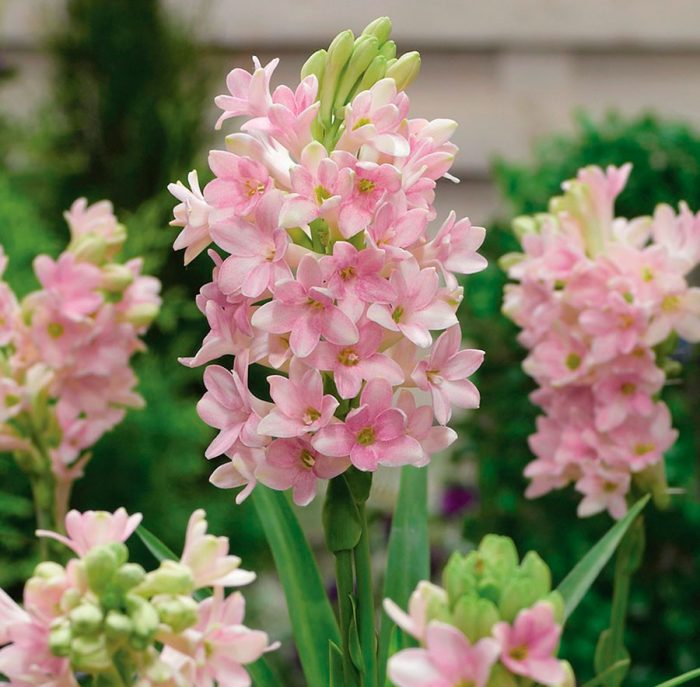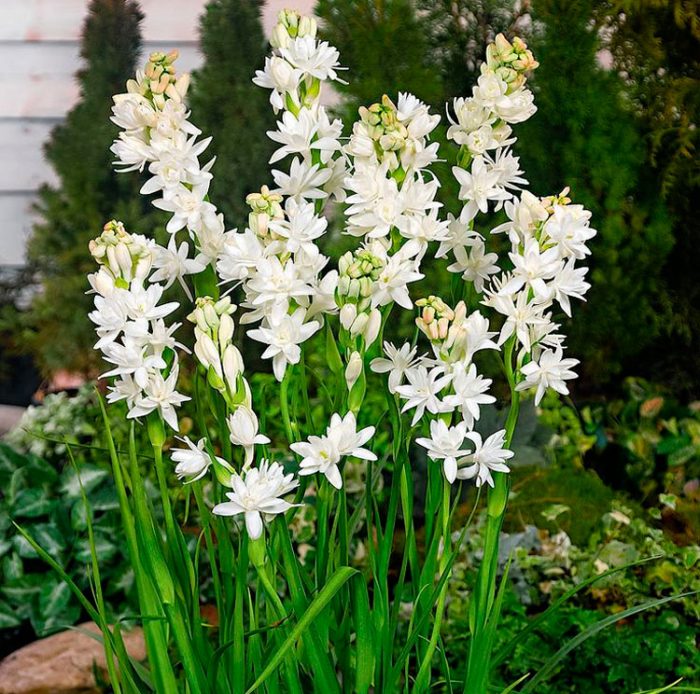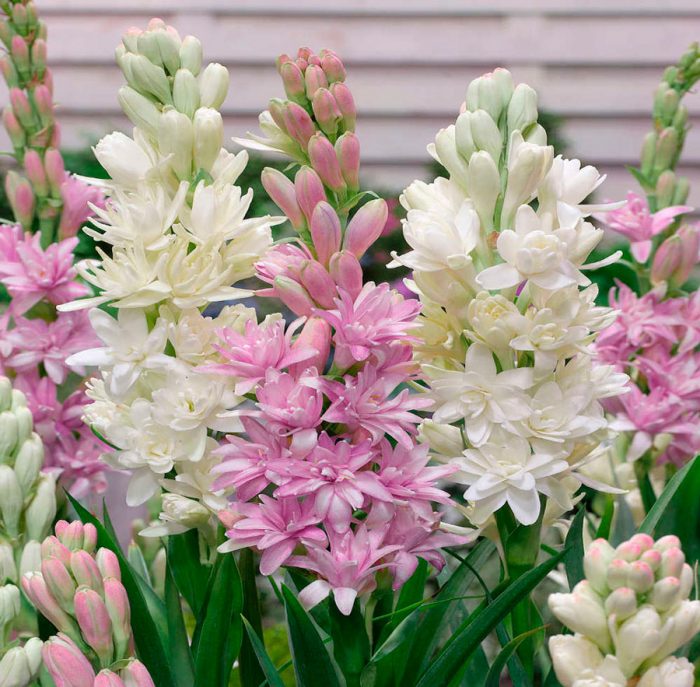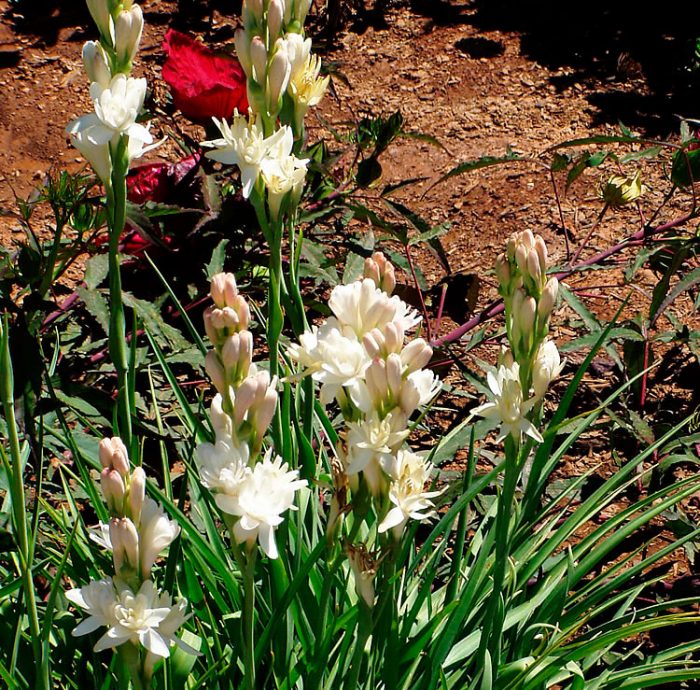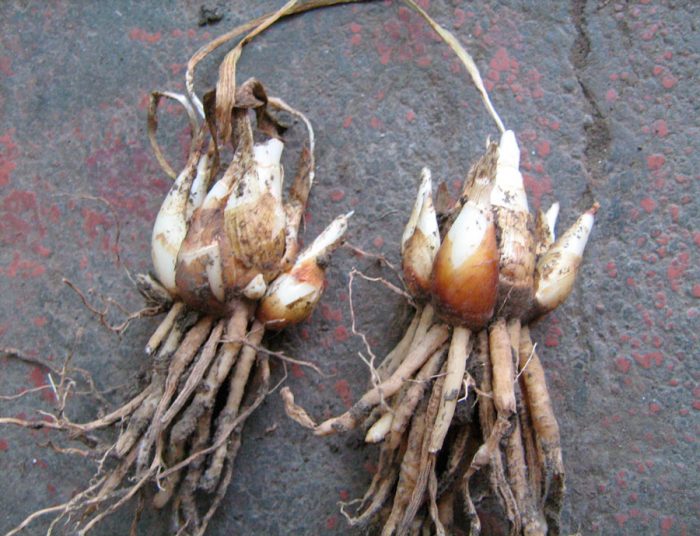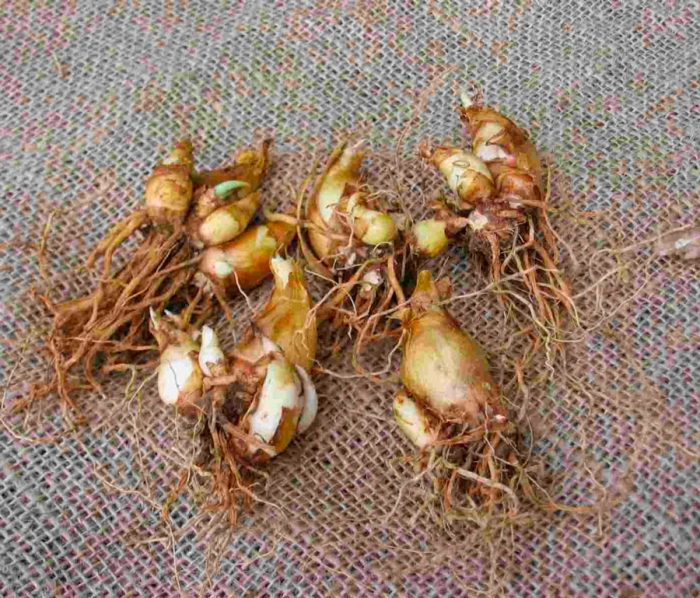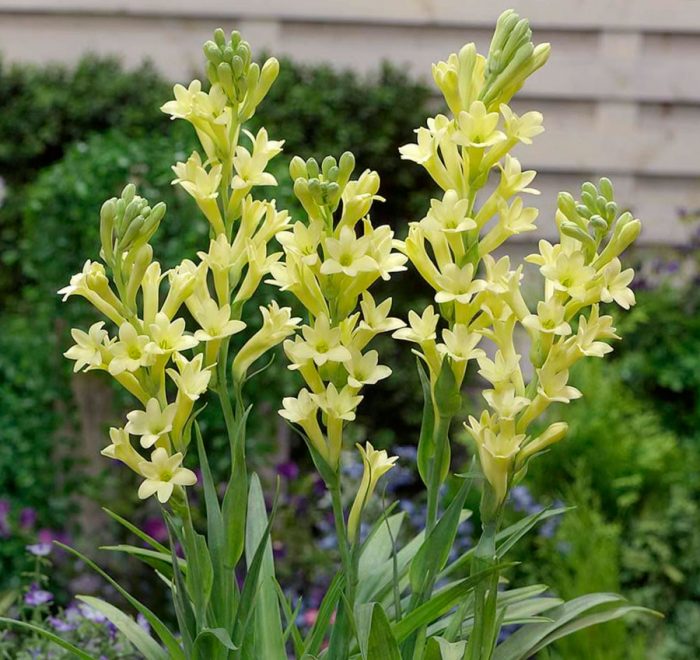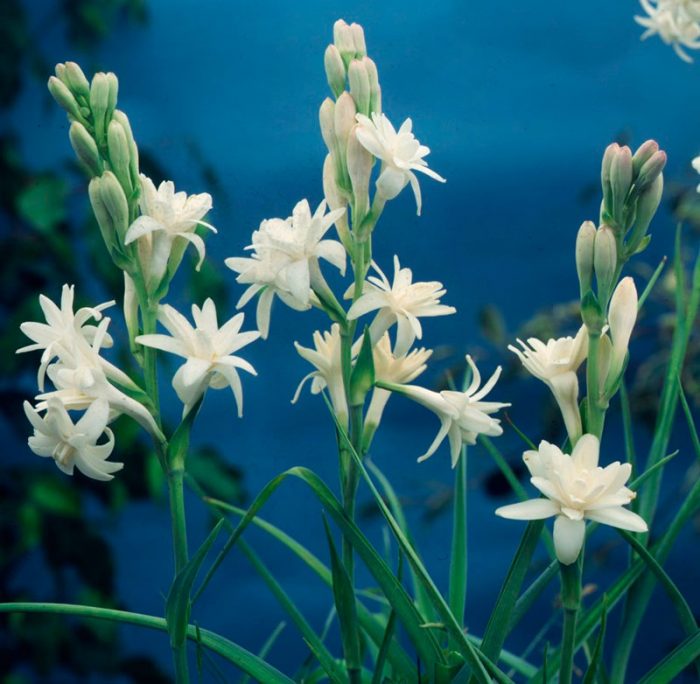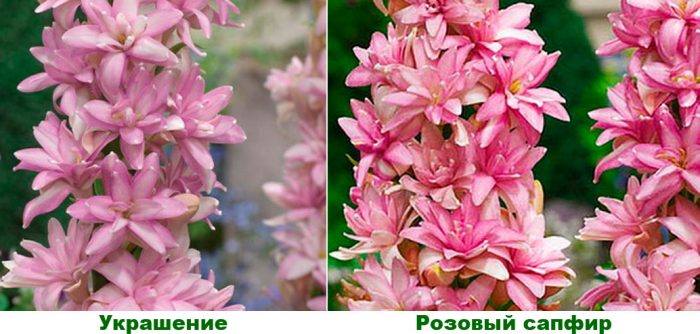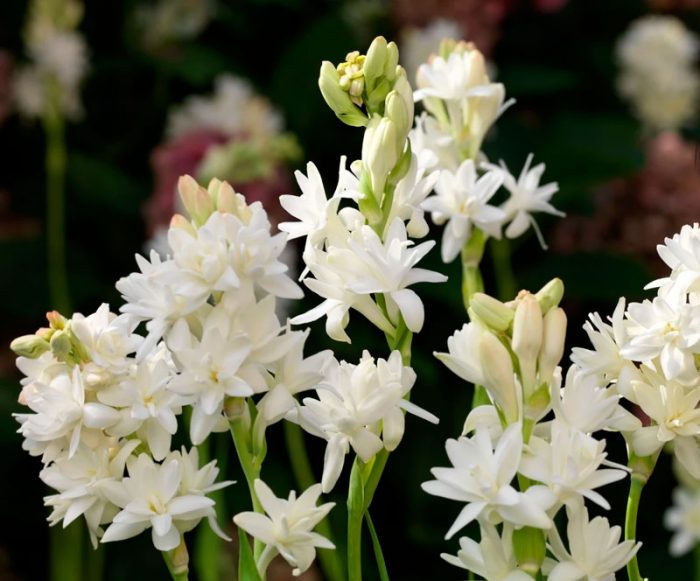The plant tuberose (tuberosa), or polyanthes (polianthes) is part of the Amaryllis family, and it comes from Central America. This flowering plant is highly decorative. Its magnificent flowers have a pleasant, strong aroma that brightens in the evening. In middle latitudes, this flower can be met infrequently, since many gardeners are afraid not to cope with such a capricious plant. But those who decided to decorate their garden with it do not regret it at all. Experienced gardeners say that if you take care of the plant correctly and choose a suitable site for it, it will look very impressive and bloom for a long time.
Content
Features of tuberose
Tuberose is a herbaceous perennial and is highly decorative. The bush has a bulbous cone-shaped tuber, the surface of which is covered with dense small brown scales. In diameter, these scales reach from 20 to 60 mm. Below the bulbs there are thin filamentous roots. The life span of the corm is from 1 to 2 years. During this period, foliage, stems appear, after which bud formation is observed. When the flowering of the bush is over, the adult bulb dies off, while several young children remain instead.
The height of the erect, slender stem is about 0.9 m. Dense sessile and narrow leaf plates can reach about 0.4 meters in length and up to 30 millimeters in width, they are dark green in color and have a rough surface. Their formation occurs in the lower part of the stem.
During flowering, a spike-shaped inflorescence is formed at the top of the shoot, which includes from 10 to 40 buds. Tubular flowers reach about 50 mm in diameter and up to 60 mm in length. Pinkish, smooth and dense petals at the tops are pointed. The opening of the buds occurs alternately, with the first to bloom those that are in the lower part of the inflorescence. Each of the flowers, after opening, dies off after three days. The inflorescences have a pungent but pleasant scent. Flowering is long, and it is observed from July to October. In place of wilted flowers, fruits are formed, which are oblong-oval-shaped capsules, inside which there are very small flat-shaped seeds.
Most often, this perennial plant is cultivated in indoor conditions, and a well-lit windowsill is chosen for it. In mid-latitudes, this flower is often grown in the open field as an annual plant. Species and varieties with double flowers are especially popular.
Growing and caring for the garden
If you want to decorate your garden with tuberose, then you need to consider that this plant is quite demanding in terms of care and growing conditions. Therefore, you should take care of it correctly and systematically. However, it tolerates various environmental changes, for example, sudden changes in temperature or transplantation. Therefore, if you follow all the rules of care, then your work will certainly be rewarded. Your garden area will be decorated for a long time with a lush, fragrant plant with very spectacular inflorescences.
Seat selection
When choosing a suitable place for tuberose in the garden, remember that it is distinguished by its light and thermophilicity. If there is too little light, then this will negatively affect the decorativeness of this bulbous perennial. First of all, pay attention to the fact that polyanthes can only grow well in an open area. But on hot days at midday, the bushes should be protected from the scorching rays of the sun, otherwise burns may form on their foliage, which will lead to a loss of decorativeness. If the plant is planted in a little shade, then its flowering will not be as spectacular and lush. On tuberose grown in the shade, no inflorescences are formed at all.
Temperature
If you are determined to start cultivating tuberose in your garden plot, then pay special attention to the fact that this is a very thermophilic plant. It will grow well only in regions with a fairly mild and warm climate. Please note that during the growing season, the air temperature should be from 20 degrees and above. If it is cooler than 16 degrees outside, then this will have an extremely negative effect on the condition and development of the plant. The flower reacts extremely negatively to the cold. If it does not receive enough heat, then its development, growth and flowering will stop.
Substrate
The fertile and light soil is ideal for growing polyanthes. It should include: sod and leafy soil, and also sand, taken in equal shares.
How to water
Such a flower is also distinguished by its moisture-loving nature. He needs high humidity for normal development. The bush should be watered sparingly, for this they use well-settled water, which should not be cold. When the bush is watered, do not forget to loosen the surface of the soil near it. This will help to avoid stagnation of fluid in the root system, which can lead to the development of rot and death of the plant.
Tuberose needs not only regular watering, it also needs to be systematically moistened with a spray bottle. The bush should be sprayed with warm water in the morning, in the evening, or in cloudy weather. If you carry out this procedure during the day, then the direct rays of the sun caught on a wet bush can cause a burn.
Fertilizer
It is necessary to feed the plant regularly so that it blooms magnificently and develops correctly. The first top dressing is carried out in May and continues to fertilize the soil until the end of the growing season. Polyanthes are fed monthly using organic or complex mineral fertilizers, which are dissolved in water.
Wintering
Corms must be removed from the ground before the first frost. They are stored in a dry place, and the children do not need to be separated. With the onset of spring, at an air temperature of 8 to 10 degrees, it is necessary to separate the children from the parent corms for growing, and this must be done several days before planting.
Distillation
When a few weeks have passed after removing the corms from the ground, they can be used for forcing. To do this, they are transferred to a warm, well-lit and ventilated room, and regularly moistened with water from a sprayer. In order to plant the corms, you need to take small pots, they are filled with garden soil, which is mixed with sand. Green shoots should appear after a very short time. And soon your home will be decorated with a delightful flowering bush.
Transfer
The plant is highly sensitive to transplants. In this regard, it is extremely undesirable to transplant tuberose at the beginning of the growing season, since there is a high probability of its death: the bush may rot, dry out or not take root. Experienced gardeners recommend replanting the bush from early to mid-April, and it should grow in one place for at least one year. If green sprouts have already appeared from the ground, then it is better to postpone the transplant until the flowering ends. Only in this case, the transplant with the subsequent division of the bush will be successful.
Preservation of decorativeness
In order for the plant to remain spectacular throughout the growing season, do not forget to cut off all wilted leaves and inflorescences from it in time. It will also have a positive effect on flowering, which will become more lush. Strong bushes need a garter as their tall stems can break due to strong gusts of wind. And thanks to the garter, the bush will not decay.


Watch this video on YouTube
Reproduction of tuberose
You can propagate polyanthes by seed and daughter bulbs. Such a plant is rarely grown from seeds, since this is a rather difficult task. The fact is that the seedlings that appear are very delicate, and therefore they often die in the first few days, while not even a single leaf has time to form on them.
Experienced gardeners recommend either buying new corms in the store, or propagating the bush with children. During one season, a large number of small children can form on an adult bulb. It is they who are disconnected from the mother corms and used for planting. The smallest babies will have to grow from three to four years old, and the largest ones - 1-2 years old. The bush will bloom only after its bulb is at least 35–45 mm in diameter. Before planting a large onion in the garden, you must first grow it by placing it in a greenhouse or in a warm room. Planting bulbs in pots for growing is carried out in March. And in the spring, when the return frosts are left behind, the bush can be transplanted to a suitable site in the garden.
If the climate in your area is temperate, then growing tuberose is best in a pot. In the warm season, the bush is transferred to the garden, and when it gets too cold outside, it is moved to a warm room. If the climate is warm and mild, then you can grow a bush in the garden. Plant the bulbs in holes one-third covered with sand. The root collar should be level with the ground surface, and the roots should look up.
Tuberose in landscape design
Spectacular tuberose looks great in both group and single plantings. To make the flower garden look brighter, you can plant various varieties of this plant nearby, differing in the color of the inflorescences. Polyanthes looks good next to gladiolus, the more you need to care for these crops in the same way.
Polyantes is used in rabatkas as a backdrop for low-growing horticultural crops. A tub with a flowering bush can be placed on a balcony, terrace, near a gazebo, etc. The inflorescences of such a perennial can be used for cutting, since they retain their freshness for about two weeks. But remember that they have a very strong smell, so it is better to keep the flowers in a well-ventilated room.
Essential oils are extracted from tuberose.They are used for the manufacture of perfumery products.
Types and varieties of tuberose
Today, 13 types of tuberose are known. However, only 2 species are grown in culture.
Tuberose, or tuberous polyanthes (Polianthes tuberosa)
No more than nine narrow, oblong-shaped leaf plates grow on the bush. Outwardly, they are similar to the foliage of cereals. The length of the leaves varies from 0.35 to 0.5 meters, and in width they can reach from 10 to 20 mm. They form a basal rosette.
Most often, highly decorative flowers in this plant are double, but they can also be simple. As a rule, they are painted white, but there are also pink ones. Flowers are part of a loose spike-shaped inflorescence. On one peduncle, from 18 to 20 flowers are formed, reaching from 40 to 60 mm in diameter.
The best varieties of this type include:
- Pearl... This medium-sized plant reaches a height of about 0.45 m. During flowering, it is decorated with spectacular large double inflorescences of a snow-white color. This variety reacts extremely negatively to cold, and therefore they prefer to cultivate it indoors.
- Sensation... This perennial plant has funnel-shaped flowers, and they are painted in a lilac-pink hue.
- Yellow chrysalis... This plant is one of the most beautiful varieties of tuberose. Its flowers are painted in a delicate pastel yellow shade.
- Decoration... Intense pink inflorescences have a pleasant, pungent odor. This variety can be cultivated outdoors, but only in regions with a mild climate. Most often, such tuberose is grown for the purpose of making perfumery, and the site is decorated with it much less often.
- Pink sapphire... The bush reaches a height of about half a meter, while it is highly decorative. During flowering, it is covered with many lush flowers. A thin lilac border runs along the edge of the light pink petals.
Polyantes broadleaf (Polianthes platyphillus Traub et Moldenke)
This perennial has a bulbous root system. In diameter, the corm reaches from 20 to 30 mm. The height of the dense, erect stem is about one meter, its surface is bare and rough. Belt-like smooth wide leaf plates form a rosette at the base of the stem. The spike-shaped inflorescence includes white funnel-shaped flowers, reaching from 40 to 50 mm in diameter. The beginning of flowering of this plant falls on April – May. Its flowers have a very pleasant scent.


Watch this video on YouTube

